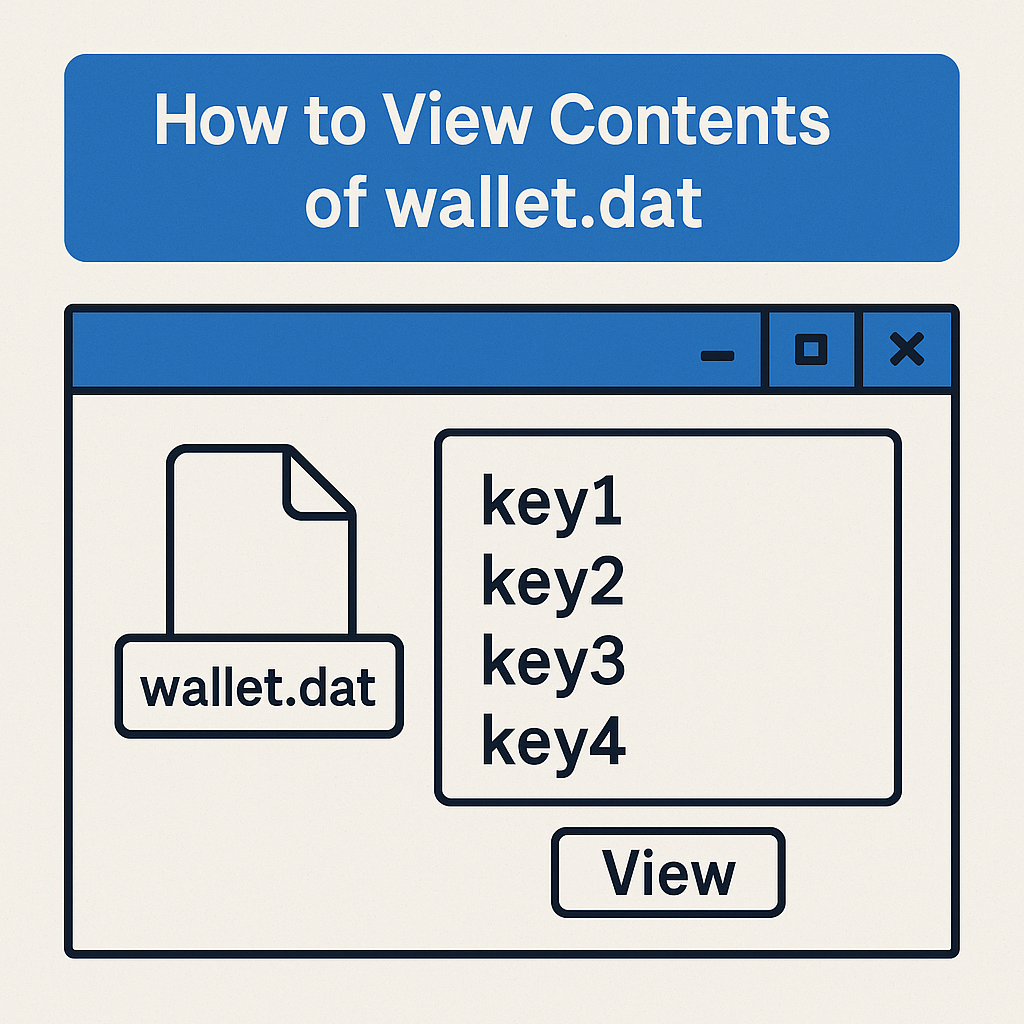In this article, we'll walk through everything you need to know about accessing, viewing, and recovering the contents of your Bitcoin wallet.dat file. Whether you're troubleshooting wallet issues, trying to recover lost funds, or just curious about what's inside your wallet file, this guide provides the technical knowledge and practical tools to help you succeed.
What is wallet.dat and Why It Matters
The wallet.dat file is the heart of your Bitcoin Core wallet. It's a Berkeley DB database file that contains crucial information about your Bitcoin holdings, including:
- Your private keys (the cryptographic keys that prove ownership of your bitcoins)
- Transaction history and records
- Key metadata and wallet settings
- Address book entries and labels
Without access to a valid wallet.dat file, you cannot spend your bitcoins, even if you can see your balance on the blockchain. This makes the wallet.dat file extremely valuable and equally sensitive. According to Bitcoin Wiki, losing your wallet.dat file without having backups is equivalent to physically losing your cash – there's no central authority that can restore your funds.
Warning: Always treat your wallet.dat file with extreme caution. It contains the keys to your cryptocurrency funds, and if someone else gains access to this file, they could potentially steal your bitcoins.
How to Locate Your wallet.dat File
Before you can view or recover the contents of your wallet.dat file, you first need to locate it. The location varies depending on your operating system:
Windows
macOS
Linux
If you're using an older version of Bitcoin Core or have set a custom data directory, the location might differ. To find your wallet in custom locations, you can:
- Open Bitcoin Core and navigate to Help > Debug Window > Information tab
- Look for "Data Directory" which shows where your wallet.dat file is stored
Bitcoin Core also supports multiple wallet files as of version 0.15.0. If you're using this feature, your wallets might be stored in a "wallets" subdirectory with different filenames.
Creating Proper Backups Before Proceeding
Essential Step: Before attempting to view, modify, or recover your wallet.dat file, creating multiple backups is absolutely critical.
Here's the safest backup process recommended by security researchers at Bitcoin.org:
- Close Bitcoin Core completely to ensure the wallet file isn't in use
- Copy the wallet.dat file to multiple secure locations:
- External hard drives
- USB flash drives stored in different physical locations
- Encrypted cloud storage (with strong encryption)
- Verify your backups by checking file size and creation date
- Consider encrypting your backups with additional password protection
Remember that any tool or method you use to access your wallet.dat file carries some risk. Working with a backup ensures that if something goes wrong, your original funds remain secure.
Methods to View wallet.dat Contents
There are several methods to view the contents of your wallet.dat file, each with different levels of technicality and security implications.
Using Bitcoin Core
The safest and most straightforward method is using Bitcoin Core itself:
- Launch Bitcoin Core with your wallet.dat file in the correct location
- Wait for the blockchain to synchronize (this can take significant time if you haven't run Bitcoin Core recently)
- Navigate to File > Open Wallet if you need to select a specific wallet file
- Once loaded, you can view:
- Addresses: Go to the "Receive" tab
- Transactions: Check the "Transactions" tab
- Private Keys: Go to Help > Debug Window > Console and type
dumpprivkey [address](requires wallet to be unlocked if encrypted)
Security Note: The dumpprivkey command will reveal your private key in
plaintext. Never use this on a computer that might be compromised or when sharing your screen.
Using PyWallet
PyWallet is a Python script specifically designed for accessing wallet.dat files outside of Bitcoin Core:
- Download PyWallet from a reputable source (like its GitHub repository)
- Install Python and the required dependencies
- Run PyWallet with appropriate command-line options:
python pywallet.py --dumpwallet --wallet=/path/to/wallet.dat
- The tool will generate a text file containing all wallet information, including addresses and private keys
PyWallet can be particularly useful for recovering data from damaged wallet files or when you need to access the wallet without running a full Bitcoin node.
Using BTCRecover
BTCRecover is an open-source password recovery tool that can also be used to examine wallet.dat files:
- Clone or download BTCRecover from its GitHub repository
- Install Python and the necessary dependencies
- For basic wallet information extraction:
python btcrecover.py --wallet /path/to/wallet.dat --extract-data
BTCRecover is primarily designed for password recovery but can be valuable for extracting basic information from wallet files.
Using Blockchain.info Import
For users who prefer web-based solutions, Blockchain.info offers a wallet import feature:
- Visit Blockchain.info and create or sign in to an account
- Navigate to Settings > Addresses > Import
- Follow the prompts to import your wallet.dat file
Important Security Warning: Uploading your wallet.dat file to any online service, including Blockchain.info, introduces significant security risks. This method should only be used as a last resort and preferably with a wallet that you plan to empty immediately after recovery.
Recovering Encrypted wallet.dat Passwords
If your wallet.dat file is encrypted (which is recommended for security) and you've forgotten the password, you have several recovery options:
Using BTCRecover for Password Recovery
BTCRecover specializes in password recovery for cryptocurrency wallets:
- Install BTCRecover as mentioned earlier
- Create a password pattern file based on what you remember about your password
- Run the tool with appropriate arguments:
python btcrecover.py --wallet /path/to/wallet.dat --passwordlist possible_passwords.txt
The effectiveness of password recovery depends on how much you remember about your password and how complex it was. According to security researchers, recovery can take anywhere from minutes to years depending on password complexity and your hardware.
Using Advanced Recovery Services
If self-service methods fail, professional recovery services exist but should be approached with caution:
- Research the reputation and trustworthiness of any service extensively
- Never send your original wallet.dat file
- Request detailed information about their methods and security protocols
- Consider legal agreements that penalize theft of funds
Professional services typically use specialized hardware and sophisticated techniques to attempt password recovery, but success is never guaranteed.
How to Extract Private Keys from wallet.dat
Extracting private keys is often necessary when migrating to new wallets or recovery situations:
Using Bitcoin Core Command Line
- Start Bitcoin Core with the relevant wallet.dat file
- Open the console (Help > Debug Window > Console)
- If your wallet is encrypted, unlock it temporarily:
walletpassphrase "your password" 600
- List all addresses in your wallet:
listaddressgroupings
- For each address containing funds, extract the private key:
dumpprivkey "bitcoin_address"
- Save these private keys securely
Using Bulk Extraction Tools
For wallets with many addresses, bulk extraction tools like wallet-key-tool can be more efficient:
- Download a trusted wallet extraction tool
- Follow the specific instructions for the tool, usually involving:
java -jar wallet-key-tool.jar /path/to/wallet.dat
- The tool will generate a list of all addresses and corresponding private keys
Critical Security Warning: Private keys represent total control over your funds. Never share them, store them in plaintext on your computer, or enter them on websites. Store extracted keys in encrypted containers or offline storage solutions.
Common Issues and Troubleshooting
When working with wallet.dat files, you may encounter these common problems:
Corrupted Wallet File
Symptoms: Bitcoin Core crashes when loading the wallet or reports corruption errors.
Solutions:
- Restore from a backup (always the best option)
- Use the
-salvagewalletBitcoin Core option:bitcoin-qt -salvagewallet - Try specialized recovery tools like Pywallet with repair options
Wallet Version Incompatibility
Symptoms: Error messages about wallet version or format not being supported.
Solutions:
- Ensure you're using the correct version of Bitcoin Core (generally, newer versions can read older wallet formats)
- Use the
-upgradewalletcommand line option - Consider extracting keys from the old wallet and importing them into a new one
Missing or Incomplete Transaction History
Symptoms: Your balance is correct, but transaction history appears incomplete.
Solutions:
- Allow Bitcoin Core to fully synchronize with the network
- Use the
-rescancommand line option - In extreme cases, use
-reindex(warning: this can take many hours)
Security Considerations and Best Practices
When dealing with wallet.dat files, security should be your primary concern:
Working in a Secure Environment
- Use offline computers when possible for highest security
- Boot from a live operating system like Tails for sensitive operations
- Disable network connectivity when examining wallet files
- Use verified, open-source tools from reputable sources
After Recovery
Once you've successfully viewed or extracted your wallet.dat contents:
- Transfer funds to a new wallet if there's any chance the original keys were compromised
- Securely delete temporary files using specialized wiping tools
- Update your backup strategy to prevent similar issues in the future
"Security is not a product, but a process." - Bruce Schneier, renowned security expert
Frequently Asked Questions
No, wallet.dat is a binary database file (Berkeley DB format) and will appear as gibberish in text editors. Opening it this way may also risk corrupting the file. Always use specialized tools designed for wallet.dat access.
Data recovery software like TestDisk, PhotoRec, or R-Studio can help recover deleted wallet.dat files. For best results, stop using the drive immediately upon noticing the loss to prevent data overwriting. Professional data recovery services may be required for physically damaged drives.
Storing an unencrypted wallet.dat in cloud storage is extremely risky. If you must use cloud storage, first encrypt the wallet within Bitcoin Core, then add another layer of encryption using tools like VeraCrypt or 7-Zip with strong, unique passwords before uploading.
You should create a new backup after every 100 transactions or whenever you create new addresses in your wallet. Bitcoin Core creates new change addresses automatically, so regular backups are essential even if you don't actively create new addresses.
Wallet.dat is a database file specific to Bitcoin Core and some other clients, containing all wallet data including multiple private keys, addresses, and transaction history. A seed phrase (usually 12 or 24 words) is a human-readable representation of a single master key from which all other keys in a hierarchical deterministic wallet are derived. Modern wallets often use seed phrases, while wallet.dat is an older format.
Conclusion
Understanding how to safely access and recover your wallet.dat file is an essential skill for any Bitcoin user. The methods outlined in this guide provide various approaches, from using Bitcoin Core's built-in features to specialized recovery tools for more challenging situations.
Remember that security should always be your primary concern when handling wallet.dat files. Take appropriate precautions, work with verified tools, and always maintain comprehensive backups to ensure the safety of your cryptocurrency assets.
Whether you're troubleshooting wallet issues, recovering lost funds, or just exploring the technical aspects of Bitcoin, properly handling your wallet.dat file can mean the difference between secure asset management and permanent loss.
Pro Tip: As cryptocurrency technology evolves, consider migrating to modern wallet solutions that offer seed phrase backups for easier recovery. However, don't discard old wallet.dat files – properly secure them in case they contain forgotten funds.
For additional support and advanced techniques, consider consulting cryptocurrency security specialists or participating in community forums where experienced users can provide guidance tailored to your specific situation.



